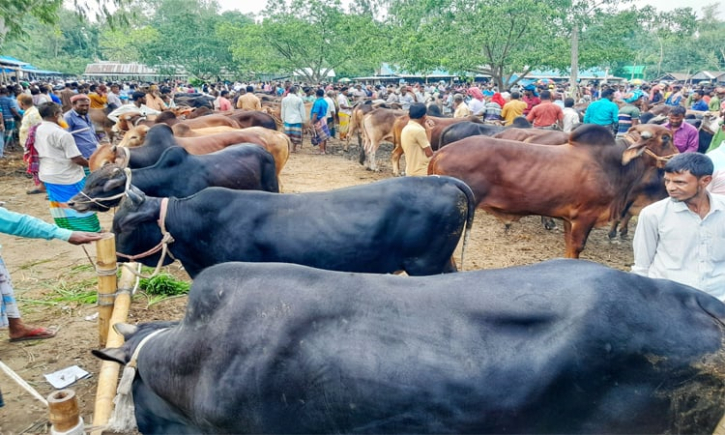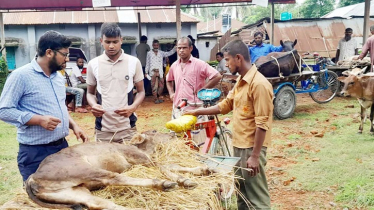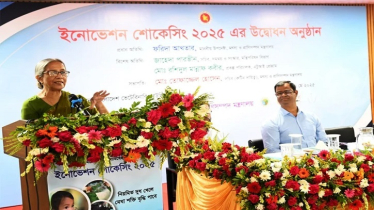
LALMONIRHAT, May 7, 2025 (AGRI24.TV)– The animal markets in Lalmonirhat district are bustling with activity as the upcoming holy Eid-ul-Adha approaches.
A significant influx of cattle, goats, buffaloes, and sheep has already been observed in the district's traditional Barabari market, one of the largest, and other animal markets. Concerned authorities believe that Lalmonirhat will play a crucial role not only in meeting the district's demand but also in supplying sacrificial animals to other regions of the country this year.
In this northern border district, the weekly animal markets in its five upazilas have now become the central point for buying and selling livestock. These markets, typically held weekly, play a vital role in the local economy.
Notable markets in the district include: Durakuti, Nababer Hat (BDR Hat), Nayarhat, Shialkhowa, Chaparhat, Doikhawa, Barakhata, and Barabari Hat, which is one of the most traditional and largest cattle markets.
A visit to Barabari Hat this Wednesday morning revealed an abundance of local cattle, with the marketplace echoing the calls of sellers. The Barabari Hat sits twice a week, on Wednesdays and Sundays. Today, by 9:00 AM, the entire market was filled to capacity with cattle. While the prices of cows ranged from Tk 50,000 to Tk 300,000, buyers showed more interest in medium-sized animals.
Mohammad Ali, a buyer, said, "I came to the market a few days before Eid because cattle prices tend to be higher closer to the festival. I bought a cow for Tk 80,000 today. The price seemed a bit high. There are plenty of cattle in the market, but we are having to pay more due to দালালদের (middlemen)."
Another buyer, Soaib Ali, stated that he purchased a cow for sacrifice for Tk 72,000. Due to financial constraints, three people jointly bought the animal.
Kamal Hossain, another buyer, said he bought a castrated goat for Tk 12,000, noting that there was a large supply of goats in the market.
Abul Hossain, a farmer from Phulbari upazila in Kurigram, reported that he brought four cows to the market. While three medium-sized cows sold at good prices, his large cow remained unsold.
Conversely, some buyers complained that they were struggling to buy their preferred animals due to the relatively high prices. Nazmul Islam from Panchagram union, who came to buy a cow early, felt the prices were higher compared to the previous week. Anisul Haq, a cattle trader from the same area, said he bought a small cow after much searching, hoping to make a small profit by selling it closer to Eid.
Ashraful Islam, a farmer from Barabari union, mentioned bringing three cows weighing 8 to 9 maunds, expecting to sell each for over Tk 220,000, but no one was offering that price.
According to cattle trader Abul Hossain, medium-sized cows are currently attracting the most buyers, with prices ranging from Tk 70,000 to Tk 100,000. He noted that the demand for larger cows has decreased due to economic reasons.
Farmers stated that the prices of cattle remain relatively low due to increased costs of গো-খাদ্য (cattle feed) and production. Afsar Mia, a farmer from the Sadar upazila, said that the production cost of cows has increased significantly compared to last year. Meanwhile, security measures have been strengthened at the markets. Authorities have taken necessary preparations to ensure smooth movement, maintain law and order, and detect counterfeit currency.
Dr. Md. Jahangir Alam, the district livestock officer, said that most farmers have fattened their cattle using natural methods this year, with the use of hormones or injections largely stopped. However, medical teams are working on the ground to prevent the sale of sick or unhealthy animals.
He further informed that the counting of sacrificial animals is ongoing, and the exact figure will be available within a day or two. However, it is estimated that there may be over 230,000 sacrificial animals in the district this year, and thousands of animals can be supplied outside the district after meeting local demand.
Overall, as Eid approaches, the purchase and sale of medium-sized cattle, rather than larger ones, has become the central focus of the animal markets in the district—a distinctive feature of this year's Eid market.





